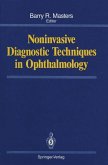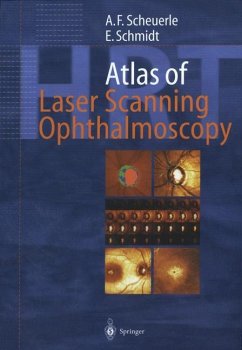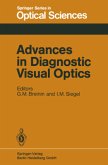Low Vision
Principles and Applications. Proceedings of the International Symposium on Low Vision, University of Waterloo, June 25¿27, 1986
Herausgegeben:Woo, G. C.
Low Vision
Principles and Applications. Proceedings of the International Symposium on Low Vision, University of Waterloo, June 25¿27, 1986
Herausgegeben:Woo, G. C.
- Broschiertes Buch
- Merkliste
- Auf die Merkliste
- Bewerten Bewerten
- Teilen
- Produkt teilen
- Produkterinnerung
- Produkterinnerung
An International Symposium on Low Vision was sponsored by the Centre for Sight Enhancement of the School of Optometry, University of Waterloo in June 1986, bringing low vision researchers and clinicians together from a number of countries. The unique feature of the conference is the multi-disciplinary approach towards low vision care. A total of 44 papers were presented in the three day period by speakers of note from the fields of optometry, ophthalmology, psychophysics, special education, nursing and vision rehabilitation. The papers deal with issues in diagnostic science, low vision…mehr
Andere Kunden interessierten sich auch für
![Noninvasive Diagnostic Techniques in Ophthalmology Noninvasive Diagnostic Techniques in Ophthalmology]() Noninvasive Diagnostic Techniques in Ophthalmology42,99 €
Noninvasive Diagnostic Techniques in Ophthalmology42,99 €![Atlas of Laser Scanning Ophthalmoscopy Atlas of Laser Scanning Ophthalmoscopy]() Alexander Friedrich ScheuerleAtlas of Laser Scanning Ophthalmoscopy41,99 €
Alexander Friedrich ScheuerleAtlas of Laser Scanning Ophthalmoscopy41,99 €![Advances in Diagnostic Visual Optics Advances in Diagnostic Visual Optics]() Advances in Diagnostic Visual Optics42,99 €
Advances in Diagnostic Visual Optics42,99 €![Physics in Biology and Medicine Physics in Biology and Medicine]() Paul DavidovitsPhysics in Biology and Medicine103,99 €
Paul DavidovitsPhysics in Biology and Medicine103,99 €![Radiation Oncology: A Physicist's-Eye View Radiation Oncology: A Physicist's-Eye View]() Michael GoiteinRadiation Oncology: A Physicist's-Eye View225,99 €
Michael GoiteinRadiation Oncology: A Physicist's-Eye View225,99 €![Biophotonics Biophotonics]() Lorenzo Pavesi / Philippe M. Fauchet (eds.)Biophotonics121,99 €
Lorenzo Pavesi / Philippe M. Fauchet (eds.)Biophotonics121,99 €![Polarized Light and Polarization Vision in Animal Sciences Polarized Light and Polarization Vision in Animal Sciences]() Polarized Light and Polarization Vision in Animal Sciences121,99 €
Polarized Light and Polarization Vision in Animal Sciences121,99 €-
-
-
An International Symposium on Low Vision was sponsored by the Centre for Sight Enhancement of the School of Optometry, University of Waterloo in June 1986, bringing low vision researchers and clinicians together from a number of countries. The unique feature of the conference is the multi-disciplinary approach towards low vision care. A total of 44 papers were presented in the three day period by speakers of note from the fields of optometry, ophthalmology, psychophysics, special education, nursing and vision rehabilitation. The papers deal with issues in diagnostic science, low vision assessment and rehabilitation. The proceedings volume is ideal for clinicians and vision scientists to update their understanding of low vision research and clinical practice.
Produktdetails
- Produktdetails
- Verlag: Springer New York / Springer, Berlin
- Softcover reprint of the original 1st ed. 1987
- Seitenzahl: 608
- Erscheinungstermin: 12. Dezember 2012
- Englisch
- Abmessung: 235mm x 155mm x 33mm
- Gewicht: 908g
- ISBN-13: 9781461291527
- ISBN-10: 1461291526
- Artikelnr.: 39491394
- Herstellerkennzeichnung Die Herstellerinformationen sind derzeit nicht verfügbar.
- Verlag: Springer New York / Springer, Berlin
- Softcover reprint of the original 1st ed. 1987
- Seitenzahl: 608
- Erscheinungstermin: 12. Dezember 2012
- Englisch
- Abmessung: 235mm x 155mm x 33mm
- Gewicht: 908g
- ISBN-13: 9781461291527
- ISBN-10: 1461291526
- Artikelnr.: 39491394
- Herstellerkennzeichnung Die Herstellerinformationen sind derzeit nicht verfügbar.
I.- 1. Measurement of Vision Loss: Theory and Practice Color Plates following page 10..- Section A.- New and Improved Contrast Sensitivity Approaches to Low Vision.- The Evaluation of the Reading Capability of Low Vision Patients Using the Vision Contrast Test System (VCTS).- Threshold and Suprathreshold Deficits in Color Vision in Optic Neuritis.- Contrast Sensitivity.- Section B.- The Effect of Blur Upon Psychophysical Receptive Field Properties.- Quantifying the Magnitude of Visual Impairment with Multi-flash Campimetry.- Spatial vs. Temporal Information in Suspected and Confirmed Chronic Open Angle Glaucoma.- Low Vision Management in Selected Eye Diseases.- The Role of X and Simple Cells in the Contrast Transducer Function of Low Vision and Normal Observers.- Differential Retinal Structural Damage Exhibited by Image Enhancement of Fundus Photographs.- The Visual Requirements of Mobility.- Visual Acuity Deficits and Chromatic Aberration in Pseudophakia.- Measurement of Central Fields Following Macular Degeneration.- Detection of Visual Field Defect Using Topographic Evoked Potential in Children.- Preliminary Study of Topographic Visual Evoked Potential Mapping in Children with Permanent Cortical Visual Impairment.- 2. Prescribing Low Vision Aids.- Prescribing Magnification: Strategies for Improving Accuracy and Consistency.- The Amorphic Fresnel Prism Trioptical System.- Sensorimotor Adaptation to Telescopic Spectacles.- Most Useful Visual Aids for the Partially Sighted.- Paradoxical Cases of Visual Improvement Offered by Above Average Lighting Levels in Cases of Albinism and Retinitis Pigmentosa.- Magnification Efficiency in the Low Vision Patient.- An Overview on the Use of a Low Magnification Telescope in Low Vision.- 3. Reading in Low Vision.- Observations from the Psychology of Reading Relevant to Low Vision Research.- Contrast Polarity Effects in Low Vision Reading.- Effect of Magnification and Field of View on Reading Speed Using a CCTV.- Predicting Reading Performance in Low Vision Observers with Age-Related Maculopathy (ARM).- 4. Low Vision Care.- Section A.- Visual Impairment and Disability: Enhancement and Substitution.- The Clinical Profile of a Young Visually Handicapped Population.- Pathology Characteristics and Optical Correction of 900 Low Vision Patients.- Assessment of Vision of Deaf-Blind Persons: A Review.- An Evaluation of Follow Up Systems in Two Low Vision Clinics in the United Kingdom.- Vision Examinations of Handicapped Children at the Oregon State School for the Blind.- Accommodation in the Visually Impaired Child.- Abnormal Arm Tone, Cigarette Smoking and Use of Blood Pressure Medication in a Sight Enhancement Clinic Population.- The City Study - Preliminary Findings.- Section B.- The Silver Pages: Are They Easier to Read?.- A Hierarchy of Perceptual Training in Low Vision.- Low Vision Performance as a Function of Task Characteristics.- II.- 1. Some Issues in Rehabilitation in Low Vision.- Section A.- National Long Term Care Facility Survey.- Rights of Low Vision Children and Their Parents.- Life Satisfaction of Low Vision Patients and Other Disability Groups: A Preliminary Study.- Section B.- Sight Enhancement Services - A Safety Net or a Spider's Web?.- Strengthening Low Vision Rehabilitation Through the Accreditation Process.- A Unique Model for a Resource/Rehabilitation Centre for Consumers with Low Vision.
I.- 1. Measurement of Vision Loss: Theory and Practice Color Plates following page 10..- Section A.- New and Improved Contrast Sensitivity Approaches to Low Vision.- The Evaluation of the Reading Capability of Low Vision Patients Using the Vision Contrast Test System (VCTS).- Threshold and Suprathreshold Deficits in Color Vision in Optic Neuritis.- Contrast Sensitivity.- Section B.- The Effect of Blur Upon Psychophysical Receptive Field Properties.- Quantifying the Magnitude of Visual Impairment with Multi-flash Campimetry.- Spatial vs. Temporal Information in Suspected and Confirmed Chronic Open Angle Glaucoma.- Low Vision Management in Selected Eye Diseases.- The Role of X and Simple Cells in the Contrast Transducer Function of Low Vision and Normal Observers.- Differential Retinal Structural Damage Exhibited by Image Enhancement of Fundus Photographs.- The Visual Requirements of Mobility.- Visual Acuity Deficits and Chromatic Aberration in Pseudophakia.- Measurement of Central Fields Following Macular Degeneration.- Detection of Visual Field Defect Using Topographic Evoked Potential in Children.- Preliminary Study of Topographic Visual Evoked Potential Mapping in Children with Permanent Cortical Visual Impairment.- 2. Prescribing Low Vision Aids.- Prescribing Magnification: Strategies for Improving Accuracy and Consistency.- The Amorphic Fresnel Prism Trioptical System.- Sensorimotor Adaptation to Telescopic Spectacles.- Most Useful Visual Aids for the Partially Sighted.- Paradoxical Cases of Visual Improvement Offered by Above Average Lighting Levels in Cases of Albinism and Retinitis Pigmentosa.- Magnification Efficiency in the Low Vision Patient.- An Overview on the Use of a Low Magnification Telescope in Low Vision.- 3. Reading in Low Vision.- Observations from the Psychology of Reading Relevant to Low Vision Research.- Contrast Polarity Effects in Low Vision Reading.- Effect of Magnification and Field of View on Reading Speed Using a CCTV.- Predicting Reading Performance in Low Vision Observers with Age-Related Maculopathy (ARM).- 4. Low Vision Care.- Section A.- Visual Impairment and Disability: Enhancement and Substitution.- The Clinical Profile of a Young Visually Handicapped Population.- Pathology Characteristics and Optical Correction of 900 Low Vision Patients.- Assessment of Vision of Deaf-Blind Persons: A Review.- An Evaluation of Follow Up Systems in Two Low Vision Clinics in the United Kingdom.- Vision Examinations of Handicapped Children at the Oregon State School for the Blind.- Accommodation in the Visually Impaired Child.- Abnormal Arm Tone, Cigarette Smoking and Use of Blood Pressure Medication in a Sight Enhancement Clinic Population.- The City Study - Preliminary Findings.- Section B.- The Silver Pages: Are They Easier to Read?.- A Hierarchy of Perceptual Training in Low Vision.- Low Vision Performance as a Function of Task Characteristics.- II.- 1. Some Issues in Rehabilitation in Low Vision.- Section A.- National Long Term Care Facility Survey.- Rights of Low Vision Children and Their Parents.- Life Satisfaction of Low Vision Patients and Other Disability Groups: A Preliminary Study.- Section B.- Sight Enhancement Services - A Safety Net or a Spider's Web?.- Strengthening Low Vision Rehabilitation Through the Accreditation Process.- A Unique Model for a Resource/Rehabilitation Centre for Consumers with Low Vision.








